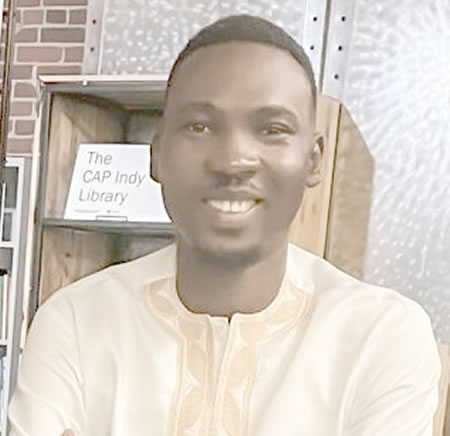🌿 Ruzu Non-Alcoholic Herbal Bitters
Ruzu Non-Alcoholic Herbal Bitters is a natural health supplement specially formulated to:
- ✅ Promote general wellness
- ✅ Detoxify the body
- ✅ Support the treatment of various ailments
Made from a powerful blend of 100% organic and medicinal herbs, Ruzu is completely alcohol-free, making it ideal for:
- 👪 All age groups
- 🌱 Health-conscious individuals
- 🌿 Anyone seeking non-alcoholic herbal remedies
Whether you're looking to boost your vitality, cleanse your system, or support healing the natural way, Ruzu Bitters offers a trusted herbal solution.
Olumuyiwa Oguntolu, who started at the Yaba College of Technology, is currently making waves in the United States where he won the American Institute of Architects (AIA) first prize for his architectural designs, earlier in the year. He speaks with SAM NWAOKO on his career and sundry issues.
After you earned an associate degree in architecture at YABATECH, you went to Bells University of Technology for a degree. This makes it look like you either love architecture or you were bent on studying the course. Did you choose architecture or were you advised to pursue it?
I chose architecture as I have always been gifted with drawings, sketching and building things with cardboards and boxes since when I was a child. I also have a very impressive handwriting. I could remember I drew so well and always helped my mom who taught Sunday school and children in church to draw her teaching boards and all. So, I wanted to do something art-related but because I was in the sciences, I chose to do architecture instead of fine arts.
You won a scholarship for graduate school in the United States for a master’s degree in Architecture due to your academic excellence and design expertise. How did this come about? Briefly share how you won the scholarship.
At a point, while working in Nigeria, I thought I needed a new challenge and was also interested in sustainable buildings, net zero and energy efficiency especially, because of climate change and various discussions around it. I thought that to design and build affordable homes, it would mean the cost of energy used will also need to be affordable for the occupants ─ water can be used and reused and solar energy can be converted into electricity. My research led me to Ball State University which was competing in the US DOE Solar decathlon. My interest got piqued. After sharing my resume, design portfolio and academic transcripts with the chair of the department and graduate programme director who were impressed and excited at the quality of my portfolio and academic performance, my application stood out, and not only was I offered admission, I also got a generous scholarship to cater for my tuition and living expenses.
The structures you are working on have some significance to your immediate community in the United States. Where would you place the importance of the projects and what reactions about them have encouraged you?
One of the most important aspects of these projects is that they activate otherwise abandoned areas, prevent urban gentrification, provide affordable housing opportunities, and promote active living by implementing walkability, sustainability, diversity, and communal spaces. The current project I am working on is on the southeast side of Lucas Oil Stadium in Indianapolis. The first task is to re-imagine the urban planning of the area to disrupt barriers that perpetuate abandonment and remediate existing vacant landscapes, increase access to nature and green spaces and to also implement sustainable and green infrastructure systems.
The reactions that have encouraged me from these projects are how thoughtful design can improve the quality of lives of people by balancing luxury, a sense of community and environmental responsibility as well as a thriving and symbiotic environment, and very importantly seeing the satisfaction in the faces of the would-be end users.
Having worked for some top architectural firms in Nigeria before moving to the USA, what are some of the culture shocks you experienced in the field of architecture when you compare the practice in Nigeria and the US?
I witnessed quite a lot and some of them are the difference in climate, which meant different ways of designing and building, different building materials and methods. I also had to acclimatise myself to their system of measurement which is different from what I was used to in Nigeria ─ new building codes/regulations, fire rating systems and of course the American accent and cultural shock of doing things.
Your project won the American Institute of Architects (AIA) Citation award for new construction under $5,000,000 in January 2024. Tell us about this and its significance.
So, The Alley House is a two-family home. It is an affordable housing solution to a global climate crisis which disproportionately impacts the poor, vulnerable, and disenfranchised. The project employs high-performance building design to ensure the comfort, health, and well-being of low-income residents who struggle to find quality affordable housing in the area and are being displaced due to gentrification pressure of market-rate and urban development, a catalyst for affordable urban infill housing in an area struggling from decades of disinvestment, vacancy, and property abandonment, to enhance quality of place, healthy lifestyles, and community interactions. Located along an east-west running alley, the Alley House provides a prototype for the alley development where there are over 70 percent vacancies on alley sites.
The Alley House won the US Department of Energy Solar Decathlon Build competition where you worked on comfort and environmental quality, durability and resilience of the building, and also produced realistic 3D visualisations. In simpler terms, what does this mean for both humans and the environment?
Generally, about 90 percent of a person’s time is spent indoors. So, Indoor Environmental Quality (IEQ) is essential to consider when designing a home. We evaluated four conditions ─ air quality, thermal condition, visual comfort, and acoustic performance. Achieving these indicators means the home enhances an occupant’s quality of life, protects human health, and reduces stress and potential illnesses. Our design decisions ultimately achieved improved levels of comfort and a healthy indoor environment for all occupants.
For durability and resilience, because Indianapolis has a well-deserved reputation for a wide range of weather conditions all year, hot humid summers and bitterly cold dry winters, we made sure to design for three main types of severe weather patterns, extreme thunderstorms that are capable of producing heavy rainfall, lightning, large hail, strong winds, and sometimes tornadoes; long periods of very humid heat without any precipitation; and dry winters that regularly drop below freezing, including winter storms that produce heavy snowfalls and accumulations of ice.
All of these weather events have the potential to disrupt the power grid, causing occupant discomfort and loss of utility services. We felt that it was important to implement a strategy to bridge gaps between power loss and full restoration of the grid. This contingency strategy ensures occupants’ safety, minimises discomfort, and prevents disruptions to the homeowners’ daily lives.
What would you say the Alley House project has made you feel as an architect in Indianapolis and beyond?
The Alley House Project gave me a lot of satisfaction and utmost sense of accomplishment and pride whenever I pass by the house, seeing the families who live there and apart from winning the first prize, I believe people care less about how much you know than how much you care.
Caring comes first. It begins with the heart. The Alley House Project has made me care more for people and the environment. From the design, to the construction of the Alley House, I have embodied a heart, hand, and head connection in my profession and environment. It has also helped in getting job referrals and opportunities.
What areas would you ask the government in Nigeria to look into for improvement, with regards to improving the architecture you left for the United States and the architecture you are practicing there?
I think the government can do better in regulating the profession and making sure only trained professionals are allowed to design and supervise buildings. The government must also promote a culture of excellence which must be adhered to in practice and international standards, and updated national building codes which prioritise safety, accessibility, and inclusion for all. Then, in terms of education and training, architecture programmes in architecture schools must be upgraded and supported to meet international standards by way of funding research, innovation, and development. Software should either be heavily subsidised for students or be available for free to maximise their potential.
We can also do better by encouraging sustainable design and construction practices, which start from having and promoting an identity, an architecture of our own that is suited for our climate and not pretentious, copied architecture. Use of less-hard surfaces and more green spaces incentives should be provided for buildings that incorporate sustainable design, construction methods, and promote locally sourced materials.
Would you, someday, bring your practice to Nigeria? And how do you hope to go about this?
Yes. I plan to do that in the future. There are many opportunities for me to apply my knowledge, skills, and expertise in a fast-developing country like Nigeria. I am already building connections and networking with colleagues and senior professionals in and beyond the built environment on the possibility of working with them in the future.
What would you advice for younger students and all those who might wish to pursue the same career as you?
My advice to younger students and others who might want to pursue the same career as mine is to first be grounded in design principles and the fundamentals. Learn to sketch out your ideas. Sketching can never be outdated. Always work with in-process models that is subject to change at different stages of the design process. Always stay curious and keep learning. Architecture is such that it is important to keep abreast of latest trends, sustainable design practices and technologies. Familiarise yourself with relevant industry software, especially parametric design tools, energy analysis tools, BIM, and leverage AI, as it is poised to be the future. Gain practical experience by way of internship, volunteering, and participating in design competitions and charrette. Also, architecture is a team sport. It is important to collaborate and network with peers, mentors, and professionals in the industry.
Finally, avoid burnout. Learn to manage your time effectively. Prioritise your health and well-being and be very organised.
How do you unwind and where is your favourite vacation spot?
I am such a home buddy. I love to stay indoors for the most part — watch some movies and football matches. But, I try to go out too — go on road trips exploring different architecture, try out different restaurants and places around my city. My favourite vacation spot is New Orleans, Louisiana, for now.
READ ALSO: ARCON president tasks architects on unity, creativity, innovation
















